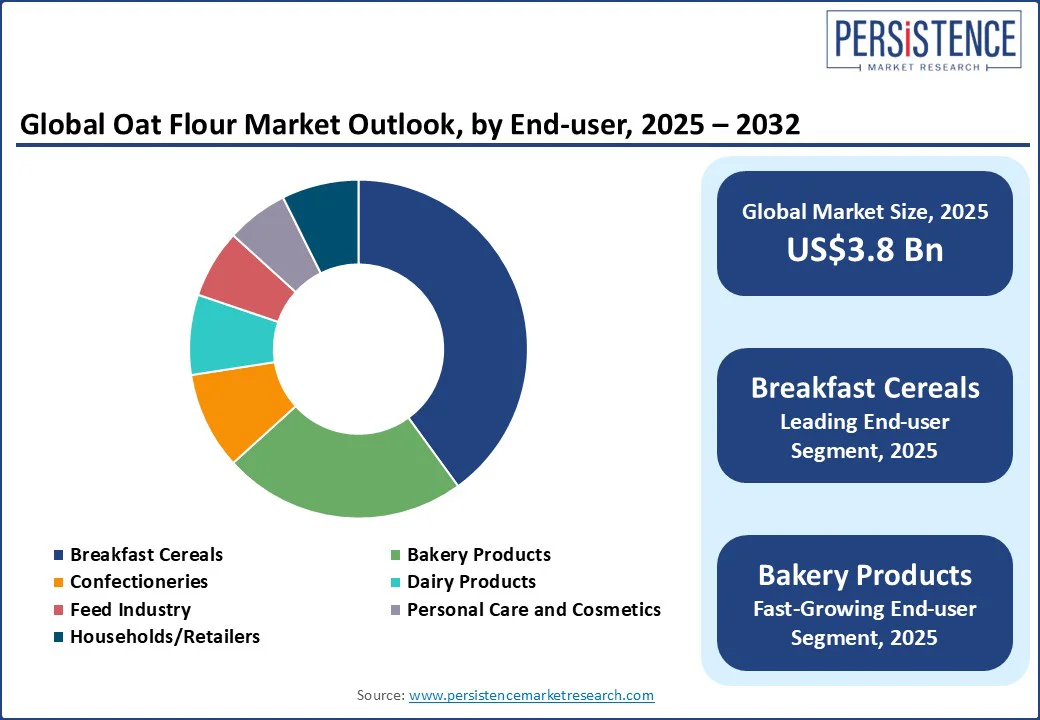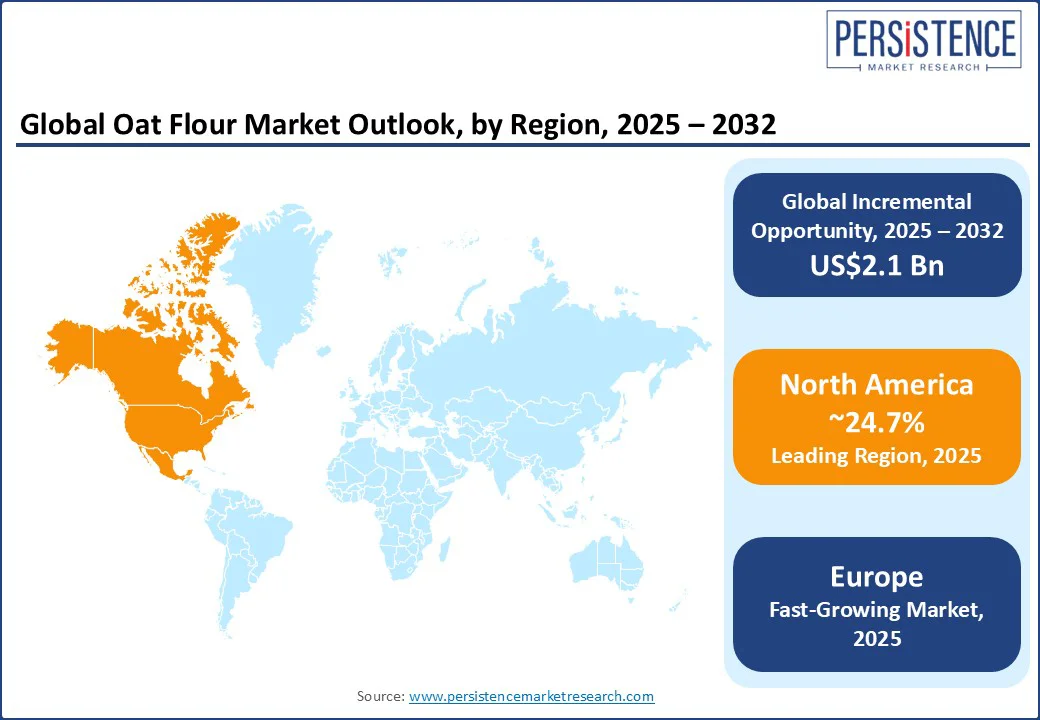ID: PMRREP25033| 180 Pages | 19 Aug 2025 | Format: PDF, Excel, PPT* | Food and Beverages

The global oat flour market size is likely to be valued at US$ 3.8 Bn in 2025 to US$ 5.9 Bn by 2032 and growing at a CAGR of 6.5% during the forecast period from 2025 to 2032.
The growth of the oat flour industry is fueled by increasing sustainability and clean-label trends globally. Leading companies are embracing targeted development, such as high-beta-glucan formulations and organic certifications to differentiate their products and gain high shares. Oat flour ingredients contain bran, germ, and the endosperm, and clinically, oat flour is highly popular for its anti-diabetic effects and lower cholesterol.

Key Industry Highlights
|
Global Market Attribute |
Key Insights |
|
Oat Flour Market Size (2025E) |
US$ 3.8 Bn |
|
Market Value Forecast (2032F) |
US$ 5.9 Bn |
|
Projected Growth (CAGR 2025 to 2032) |
6.5% |
|
Historical Market Growth (CAGR 2019 to 2024) |
5.2% |
Increasing awareness of oat flour’s role in regulating blood sugar and supporting cardiovascular health is becoming a key demand driver. This trend is especially evident in markets where lifestyle diseases are on the rise. Oat flour is naturally rich in beta-glucan, a soluble fiber that slows carbohydrate absorption, leading to a steady post-meal glucose response.
This functional benefit is increasingly showcased by health authorities, such as the U.S. Food and Drug Administration (FDA) and the European Food Safety Authority (EFSA). They allow approved heart health claims for products containing a sufficient daily intake of beta-glucan.
Cardiovascular health positioning is also effective among aging consumers and those managing high cholesterol. South Korea’s CJ CheilJedang, for example, recently introduced an oat flour bread enriched with extra beta-glucan.
The company promoted the product as a daily staple for heart care. The diabetes prevention narrative further extends the product’s appeal. In India and China, where Type 2 diabetes prevalence is rising, oat flour-based products are marketed for their low glycemic index and ability to help manage blood sugar.
While oat flour is naturally gluten-free, it can trigger digestive discomfort in certain individuals due to its high soluble fiber content, particularly beta-glucan. For people with sensitive digestive systems, a sudden increase in oat flour consumption that causes bloating, gas, or changes in bowel movements discourages the user from repeating purchases. This is relevant for markets where consumers are not accustomed to high-fiber diets, making gradual dietary integration essential.
Another factor limiting the adoption is the risk of cross-contamination with gluten during processing. Oats are often milled in facilities that also handle wheat, barley, or rye, resulting in trace gluten presence. This poses a health risk for individuals with celiac disease or severe gluten intolerance, who require certified gluten-free oats. These concerns drive risk-averse consumers toward alternative gluten-free flours, including rice or almond flour, slowing oat flour’s penetration in the strict gluten-free segment.
Surging use of oat flour as a thickening agent in soups, sauces, and gravies is opening niche growth opportunities, specifically in the plant-based and clean-label food segments. Its fine texture allows it to blend smoothly without clumping, while its mild, slightly nutty flavor complements both savory and sweet applications. Unlike cornstarch or refined wheat flour, oat flour adds dietary fiber and protein, enabling food brands to market products with improved nutritional profiles.
It caters to the ongoing shift toward functional comfort foods, where indulgent items such as creamy mushroom soups are reformulated to provide benefits without compromising taste. In the ready-to-eat and meal kit segments, oat flour’s versatility is bolstering adoption. Brands are incorporating it into shelf-stable gravies and sauces as it withstands freezing and reheating without separating.
In terms of nature, the market is bifurcated into organic and conventional. Out of these, the organic oat flour segment will likely account for about 62.3% of the share in 2025 as it is produced without synthetic pesticides or fertilizers, which resonates with consumers concerned about chemical residues in staple foods. This concern has become prominent in recent years following studies revealing trace pesticide contamination in non-organic oat products in markets, including the U.S. and EU, compelling several buyers to trade up to certified organic options. The premium positioning of organic oat flour also allows manufacturers to maintain high margins while targeting a loyal consumer base.
Conventional oat flour is seeing steady demand as it provides an affordable alternative to organic variants while still delivering the nutritional benefits that surge oat-based product adoption. For large-scale food manufacturers, the low price point of conventional flour allows for competitive retail pricing without sacrificing the high beta-glucan content and mild flavor that consumers expect. Conventional oat flour further benefits from a large supply base, as it is sourced from high-yield commercial farms without the certification and acreage limitations of organic production.
By end-user, the market is divided into breakfast cereals, bakery products, confectioneries, dairy products, feed industry, personal care and cosmetics, and households/retailers. Among these, breakfast cereals are speculated to hold nearly 39.2% of the oat flour market share in 2025 due to the ingredient’s ability to provide a naturally creamy texture and mild flavor. This makes it easy to blend with other grains or form into extruded shapes for ready-to-eat cereals. Its beta-glucan content further enables manufacturers to market heart health benefits under approved claims in the U.S., Europe, and Australia. In these markets, regulatory frameworks permit such labeling.
Bakery products are projected to witness decent growth as oat flour delivers both functional and nutritional benefits that cater to the current consumer demands. Its fine texture and natural binding properties make it suitable for a wide range of applications, without requiring heavy modification of existing recipes. Oat flour can further replace part or all of the wheat flour in gluten-free recipes while still providing structure and moisture retention. This gluten-free adaptability is hence considered a key driver.

North America is anticipated to account for approximately 24.7% of the share in 2025 due to the rising demand for gluten-free, plant-based, and clean-label products. The U.S. oat flour market is predicted to dominate through 2032 as consumers seek health-oriented baking, breakfast mixes, and snack formulations. Organic oat flour is experiencing steady growth as it appeals to consumers who link whole-grain and minimally processed products with better nutrition and environmental responsibility. This trend is evident in metropolitan areas where bakeries, foodservice outlets, and packaged goods companies are emphasizing organic certification on labels.
Conventional oat flour, however, continues to serve a large segment of industrial bakers and budget-driven retail brands, striking a balance between cost and nutritional content. Although demand is rising, supply chain stability remains a key concern. North America’s oat yields are vulnerable to climatic shifts, with droughts and wet harvest seasons impacting quantity and quality. Gluten-free bakeries in the U.S. have reported switching suppliers when shipments of organic gluten-free oat flour became inconsistent.
Europe is poised to witness considerable growth, with Germany, the U.K., and France leading in terms of consumption and processing. This is attributed to a rising consumer shift toward organic, gluten-free, and clean-label products. At the same time, the presence of a well-developed milling infrastructure that caters to both large-scale food manufacturers and artisanal producers is pushing growth. Nordic countries, specifically Sweden, are exhibiting momentum, with oat flour use skyrocketing in baking due to the increasing popularity of vegan and gluten-free diets.
Europe’s strict gluten-free regulatory environment is another key factor influencing the market. European Union (EU) norms require oat-based products to contain less than 20 ppm of gluten, which has increased compliance costs and slowed product launches. Some new gluten-free entrants have withdrawn entirely due to annual compliance costs exceeding half a million dollars, while others have faced delays of up to six months before products could be released. These norms, while challenging for producers, also create a competitive advantage for established brands that have the resources to meet these standards consistently.
Asia Pacific has emerged as a key market for oat flour owing to rising health consciousness as consumers shift toward high-fiber and gluten-free products. Additionally, increasing awareness of celiac disease, interest in plant-based diets, and the adoption of Western-style baking trends in urban areas are propelling demand. In South Korea, cafés and boutique bakeries are introducing gluten-free muffins, pancakes, and breads made from oat flour, often marketed as healthier and trendier alternatives to wheat-based products.
In Australia and New Zealand, oat flour is making inroads into infant nutrition, with brands using it in baby food blends for its hypoallergenic profile and gentle digestibility. They are targeting parents seeking clean-label and minimally processed ingredients. Retail channels are broadening their oat flour ranges. Supermarkets such as Woolworths and Coles in Australia now dedicate more shelf space to gluten-free oat flours. In Japan, convenience store chains, including Seven-Eleven, stock single-serve oatmeal and granola formats using oat flour.

The global oat flour market is characterized by a layered competitive structure, with large grain processors such as Richardson, Grain Millers, Morning Foods, and Blue Lake Milling controlling bulk supply for industrial use. Consumer-facing brands, including Bob’s Red Mill and Arrowhead Mills, lead packaged retail segments. This creates a divide where global processors influence pricing and availability through control of raw grain and milling capacity. Mid-sized specialty mills capture margins through organic or gluten-free positioning, and small brands compete by highlighting origin, milling techniques, or unique nutritional claims.
The oat flour market is projected to reach US$ 3.8 Bn in 2025.
Rising consumer demand for gluten-free food and the integration of oat flour into convenient formats such as ready-to-eat cereals are the key market drivers.
The oat flour market is poised to witness a CAGR of 6.5% from 2025 to 2032.
Developments in oat flour-based thickening agents and expanding retail infrastructure in emerging countries are the key market opportunities.
The Hain Celestial Group, Inc., Naturex S.A., and Bagrry’s India, Ltd. are a few key market players.
|
Report Attribute |
Details |
|
Historical Data/Actuals |
2019 - 2024 |
|
Forecast Period |
2025 - 2032 |
|
Market Analysis |
Value: US$ Bn |
|
Geographical Coverage |
|
|
Segmental Coverage |
|
|
Competitive Analysis |
|
|
Report Highlights |
|
|
Customization and Pricing |
Available upon request |
By Nature
By Distribution Channel
By End-user
By Region
Delivery Timelines
For more information on this report and its delivery timelines please get in touch with our sales team.
About Author